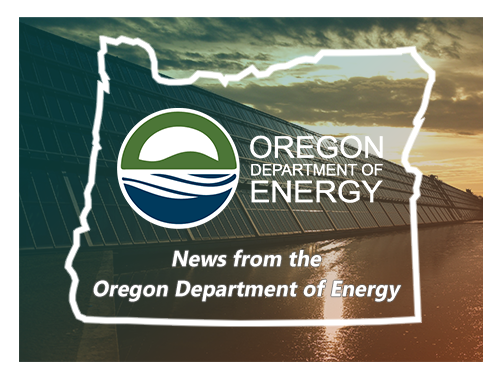Our 2024 Biennial Energy Report features a set of Energy 101-style pieces designed to build the foundation of Oregon’s energy story. The 101s were developed for people new to energy or specific energy topics, along with those looking for a resource to help tell the story of how energy systems affect their work and interests. One of our 101s focused on climate change effects on the energy system – a timely topic for Earth Month.
Read MoreThe Oregon Department of Energy will host an informational webinar on February 19 to introduce Oregonians to our 2024 Biennial Energy Report. ODOE published the report on November 1; this fourth edition focuses on fundamental information about energy in Oregon and emerging energy issues.
Read MoreIn our last newsletter of 2024, ODOE shares our latest Biennial Energy Report, celebrates an important electric vehicle milestone, welcomes a new RARE Member to the team, and more.
Read MoreThe Oregon Department of Energy published its 2024 Biennial Energy Report on November 1, featuring fundamental information and data about energy in Oregon, highlights of emerging energy resources, and foundational “Energy 101s” on current topics and technologies.
Read MoreIn this month’s newsletter, ODOE announces a new $113M federal award to develop home energy rebate programs, celebrates Hispanic Heritage Month, provides an update on the Oregon Energy Strategy, plugs into a new Grounded podcast episode, and more.
Read MoreThe Oregon Department of Energy is developing our 2024 Biennial Energy Report, and we want to hear from you!
Read MoreOregon is well-known for its incredible agricultural sector – filberts, hops, cherries, peppermint, milk products, hay, wine grapes, onions, and much more support local communities across the state. According to the Oregon Department of Agriculture’s annual statistics book, more than 37,000 farms are spread across 16 million Oregon acres, growing or raising more than 200 products valued at over $5 billion. Oregon agricultural producers use energy for a variety of needs, including powering vehicles and equipment, irrigating fields, cleaning or chilling products, and many other uses.
Read MoreRental homes are typically less energy efficient than owner-occupied homes, and renters usually can’t make significant energy efficiency improvements – such as installing high-efficiency appliances, new windows, or improved insulation – because they don’t own the property. National and local efforts are working to increase access so renters can benefit from improved efficiency.
Read MoreAs Oregon moves toward a clean energy future, including 100 percent clean electricity by 2040, we’ll need a robust workforce to help make it happen. Oregon will need electricians to install and maintain electric vehicle charging, engineers and construction experts to build and maintain solar, wind, battery, and other clean resources to support the grid, and energy efficiency technicians to reduce our energy consumption to help keep energy costs low – among many other potential family-wage jobs.
Read MoreThe way energy is produced and delivered varies widely, and multiple factors can affect how much Oregon consumers end up paying for their energy needs. The Oregon Department of Energy’s 2022 Biennial Energy Report included an Energy 101 discussing consumer energy cost drivers, from geography to regulation to market forces – and more.
Read MoreSome energy grid planners and utilities have identified a need for energy storage resources that can provide energy to the grid for longer durations. In the Oregon Department of Energy’s 2022 Biennial Energy Report, we dive into what long-duration energy storage might look like, and highlight an Oregon-grown company looking to forge a path for long-duration storage.
Read MoreAbout a quarter of Oregon’s overall energy use comes from homes, from lighting and cooking to heating and cooling. Making the switch to energy efficient appliances and technologies means less energy use, lower energy bills, fewer greenhouse gas emissions, and more comfortable homes. Heat pumps, which move heat rather than create it, are becoming more popular in Oregon homes thanks to their efficient heating and cooling, lower energy use, and big incentive savings on the horizon.
Read MoreIn our last newsletter of the year, ODOE publishes the 2022 Biennial Energy Report, releases a new study on renewable hydrogen, announces a request for information on Grid Resilience, plugs into the latest Grounded podcast episode, and more.
Read MoreThe Oregon Department of Energy published its 2022 Biennial Energy Report on November 1, featuring fundamental information and data about energy in Oregon, highlights of emerging resources and technology, and deeper dives into challenging policy questions.
Read MoreIn this month’s newsletter, ODOE announces 21 recipients for our Community Renewable Energy Grant Program, gets ready to publish the 2022 Biennial Energy Report, shares an update on federal energy dollars coming to the state, and more.
Read MoreIn this month’s newsletter, ODOE opens application portal for Community Renewable Energy Grants, practices nuclear emergency response at Hanford, helps Oregon rural small businesses and agricultural producers identify energy savings, and more.
Read MoreThe Oregon Department of Energy is kicking off development of our 2022 Biennial Energy Report. For 2022, the project team will address required topics through a data-driven process, equity considerations, and assessment of the policy landscape – and we’d like your input!
Read MoreEnergy storage is a hot topic these days. How does it work? While electricity can’t be stored in tanks and pipelines, it can be stored in batteries – ranging from the AAAs in your TV remote to a several-kilowatt battery for your home to 1 megawatt or greater for utility-scale storage.
Read MoreAs more utilities look to replace fossil-fuel resources with more economic renewable resources, offshore wind energy is emerging as a potential option for the United States. Offshore wind turbines are located in windy waters off coastal shores, away from land.
Read MoreIn this month’s newsletter ODOE launches new energy audit program, shares reflections on the climate crisis, spotlights evolving wholesale electricity markets, provides an update on the ORESA project, and more.
Read More

















